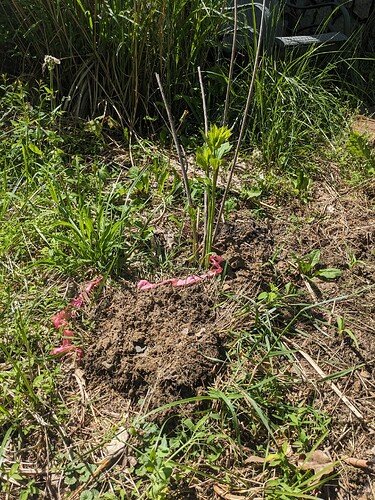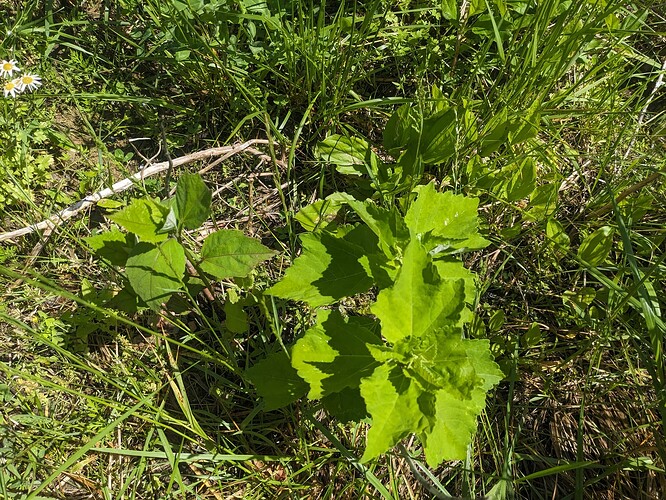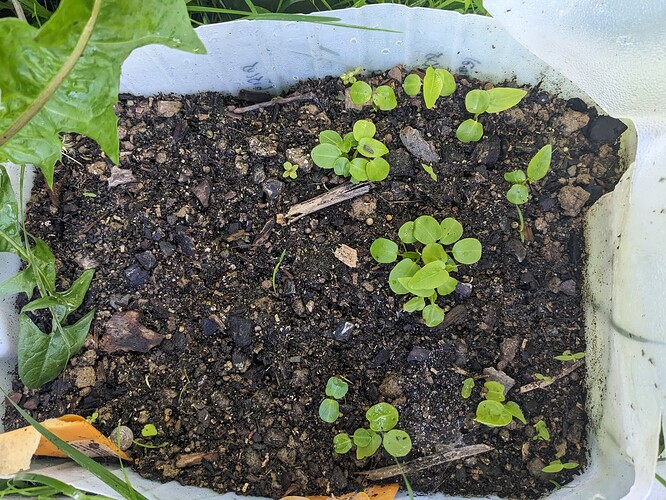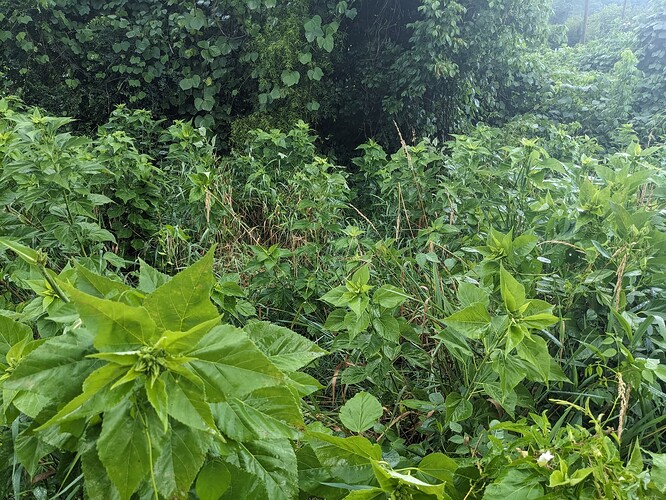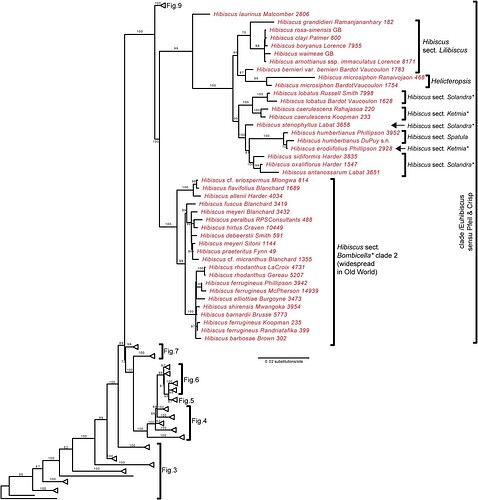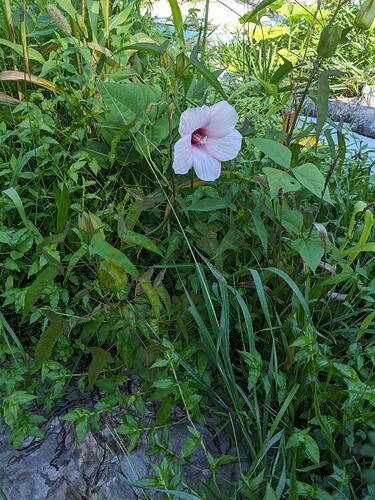Sure, I can do that! Do you want rose of sharon seeds, too? That same neighbor has rose of sharon (which is verrrrrrrry common in landscaping here), so I can easily ask her if I can grab seeds from those plants, too.
Don’t know, I have yet to try rose mallow
Nice! For sure! It’s probably a different cultivar of Rose of Sharon than the ones I got. Do you remember the flower color?
Pink, in the case of both species.
There are also white and purple rose of sharon bushes that other neighbors around me have. And I’ve seen both light pink and dark magenta, which are different hues though not different colors. If there are any colors in particular you’re interested in, I can ask those neighbors if I can harvest seeds from those plants in fall.
I’m more so just collecting diversity, so the more different colors the better, although they probably crossed with the white & Purple already right? Cuz pollinators flys form neighbor to neighbor bush.
Yeah, random crossings are likely. ![]() There is also the possibility that the pink color could be a case of incompete dominance (one red allele, one white allele) – I know that’s how it works in some species. Does anyone know if that’s true with mallows?
There is also the possibility that the pink color could be a case of incompete dominance (one red allele, one white allele) – I know that’s how it works in some species. Does anyone know if that’s true with mallows?
Types of Hibiscus moscheutos
The boundaries on what has been described as H. moscheutos have changed somewhat over time and varied between authorities. Even though it is a century old, I’ve found these descriptions of subtypes useful.
The types described in this excerpt include populations of what, at the time, some authorities were calling H. palustris and H. moscheutos. Palustris is now generally considered part of H. mocheutos or to be a subspecies of H. moschetuos.
Excerpt from NOTES REGARDING VARIABILITY OF THE ROSE MALLOWS
A. B. Stout. 1917.
…
Self-fertilized progenies were grown to determine what forms breed true, and cross-pollinations were made between various forms and between various well recognized species in the attempt to reveal clews as to their relationship and to the variability that may arise in nature by natural crossing.At the present time the cultures of Hibiscus Moscheutos grown at the New York Botanical Garden include several races which appear to breed true and which are sufficiently distinct to be readily identified. Unless specifically mentioned the characters agree closely with those of the species as described above. The color determinations were made with the aid of Ridgway’s Color Standards and Nomenclature.
Race 1
No red in foliage. Corolla-blades amaranth pink, except for an almost pure white area of a radius of about three eighths of an inch at base surrounding stamen column. Stamens of nearly equal length, those at base of column only slightly shorter. Pollen yellow. Stigmatic lobes broad. Pods blunt. The general character of this race is shown in the colored plate presented in the National Geographic Magazine 39: 597 and which, as it now seems, may be taken as a biological type of the species.
Race 2
Like race 1, but with darker shade of coloration in petals.
Race 3
Like race 1, but decidedly paler, the color being noticeable but of a very pale diffuse pink.
Race 4
Like race 1 , but with the white of the center extending out along the main veins nearly to the tips of the corolla-lobes in radiating streaks.
Race 5
An alba form, nearly pure white; faintest suggestion of pink coloration in buds and occasionally in flowers. Pollen almost white, noticeably less yellow than in races 1-4.
Race 6
An eyed form : Tyrian rose at base of petals for radius of about half an inch, the color extending out in veins into the blades which are chiefly a dead white. Pollen white. Considerable red pigmentation in stems and in the petioles, and veins of the leaves.
Race 7
Red coloration decided in stems and in the petioles and veins of the leaves. Corolla fully colored, amaranth pink at tips of lobes, the color gradually becoming more intense until at the base of the stamen column it is almost Tyrian rose; color slightly more intense in veins of lobes; areas of color extending up stamen column and into stamens. Pollen yellow. Stigmatic lobes smaller than in forms 1-6. Pods decidedly beaked.
This form is undoubtedly sufficiently different from Hibiscus Moscheutos to be considered as a distinct species. In respect to flower color and shape of capsule especially, it is decidedly different from ordinary forms of the species. Thus far I have seen but one plant of this form growing wild. Two generations of self -fertilized offspring have bred true.
Various crosses have been made between several of the above forms. In general the F1 generation in each case has been rather intermediate. An F2 generation has been grown of the cross between Races 5 and 7; the characteristics of Race 7 pre-dominated in the large majority of this generation.
…
M. L. Fernald uses only three main types. This description of the leaf shapes and proportions has been useful to me.
Excerpts from HIBISCUS MOSCHEUTOS AND H. PALUSTRIS
M. L. Fernald. 1942
For three and a half centuries three variations of the native Hibiscus of the Atlantic slope of the United States, with lanceovate to subrotund leaves green and glabrous or merely scabridulous above and soft-pubescent beneath, have been cultivated in Europe. These include (1) the more northern plant with the principal cauline leaves, below the inflorescence, broadly ovate to suborbicular in outline and often angulate-lobed (suggesting maple leaves), averaging three fourths as broad as long but sometimes even broader than long, with most or all peduncles free, except sometimes at base, from the subtending petioles, the petals pink to purple, with deeper-colored base, the branches of the style pilose or hirtellous, the capsule subglobose or depressed; (2) a plant quite similar to no. 1 but with creamy-white corolla with red center; and (3) a very different plant, with the principal leaves narrowly ovate to ovate-lanceolate and unlobed or only obsoletely so, or the lower tricuspidate, long-acuminate, averaging only one-third as wide as long, some of the peduncles fused to the lower halves of the subtending petioles, the corolla white or whitish with crimson or red eye, the long styles with glabrous branches, the unexpanded capsules conic-ovoid.
So generally were no. 1 (with relatively broad and short leaves, free peduncles and pink corollas) and no. 3 (with narrower and proportionately longer leaves, often fused peduncles and petioles, and white corollas with red centers) in European gardens and so frequently were they illustrated in full color…
Following my post about classifying subtypes within Hibiscus moscheutos, I would like to visit the topic of edible leaves.
This swamp rose mallow above seems to fit Races 1-5 of Stout (1917), having come from a population of mixed white and pink corollas. It would be classified as type Number 3 from Fernald (1942).
Even the smallest of these leaves are fiberous and unpleasant to eat raw. There may be a way to use the cooked leaves, but after some very preliminary trials it doesn’t seem like they would be very useful cooked either.
This second swamp rose mallow photo seems to fall into the other categories; either Race 6 or 7 in the Stout classification, and either No. 1 or 2 in Fernald. I am hoping that the maple like leaf shapes are reliable indicator of this type. These leaves are a little bit fiberous, but can be eaten raw. Cooked would be better. ‘Spinach’ seems like the right word for how these greens can be used, but they are a little bit more like cabbage than spinach in texture.
This roselle has leaves that taste great, and could be used in salad. They have a cranberry-esque flavor like roselle tea. They also remind me of cabbage, but are less fiberous than the previously described H. moscheutos. If the perennial species could be moved in the direction of these roselle leaves I would be very pleased.
This ‘true okra’ plant is currently teeming with ants stealing its moisture, but I ate a few leaves recently. These leaves are bland in a way that would be good for spinach (or cabbagy) greens. They have little or none of the toughness/stringyness/fiberousness of the H. moscheutos.
Rose of Sharon - I’m not sure I have a photo of this plant handy
Even the smallest leaves are fibrous or stringy. Do people really eat these leaves?
Excellent Photos + useful info on the varieties of Hibiscus moscheutos. I like to think of Phylogenically close species as varieties of a single species.
I mostly eat the flower petals & avoid the leaves because they are too fibrous. Especially when Basswood/Linden, Hollyhock & mallows are much much softer & nicer to eat.
WOW! Now that’s interesting. Why does it taste like cranberry roselle flavor? Perhaps it’s more closer to roselle than to Hibiscus moscheutos?
Hi Mark, I realized I was posting pictures to the general discussion thread so I moved to your thread. Hope that’s ok.
I’m really fascinated with seeing what the mallow is doing to cope with winter. Haven’t really paid attention before.
The sun is shining in the high tunnel now so it’s well above freezing now. When I looked earlier this morning, the plants were more wilted, now they are perked up. I’m assuming this means they are sending sap down to the roots at night and back up when it gets warm again.
After last year’s droughts, we experienced a few very low temperatures, and then a flood. The local wild populations that are the genetic basis for this project were generally under water.
I believe that a flood a couple of years ago helped propagate the wild rose mallows I have been visiting. I expect that this year’s flood will have destroyed some populations and created new ones in different spots. That is the case for my rose mallow plantings: some were alternately frozen and under a couple of inches of water for a period of time.
I’ve lost some of my plantings, but others survive as indicated by new shoots growing. I’m moving the lowest-altitude individuals a few feet higher for safety and I took these photos.
One shows the root mass of a couple of woody stems from last year. The roots do tend to cluster tightly around the base of their associated stem which isn’t very clear from my photo.
Because of my schedule I am not sure I will be updating this thread as frequently this year. Regardless, I do plan to continue growing and selecting for the project.
Established plants continue to re emerge. I think I’ve had a high survival rate. I also have new seedlings, some representing potential wide crosses for the future. I’m a bit behind on my plans for the season but I feel like I’m close to having this project planted out.
Even if I don’t make manual crosses this year, establishing perennials and seed increase will advance the project regardless.
Amazing! So many seedling doing so well!
That’s the attitude that wins!
This paper pertains to wide crosses involving perennial hibiscus. This is with ornamental purposes in mind but still pretty interesting.
Rose mallow is starting to bloom here. I don’t have a lot of attention to give the project but I’m trying to make sure that I keep it moving forward.
This wild population that I have photographed in the past is losing its long-term battle against kudzu. I want to make sure I have these good genes in my population because I won’t be able to keep coming back to this spot forever.
Edit: I am adding a photo of one of the plants in my garden descended from this population
The study mentions the biggest problem is many Hibiscus belong to completely different sections (In other words each section is like a whole separate genus).
Speaking of which, Okra (Abelmoschus esculentus) is nested in the Hibiscus genus. Either everything gets lumped under a huge Hibiscus genus or each section becomes it’s own unique genus (The hybridization incompatibility is just that high). They also said F1 was sterlie? Sounds like they need to do some introgression and more pollen mixing to smooth out these issues.
That being said, mentor pollination & wide hybridized off-spring could make this easier & is worth a try for cross-section hybridizations.
Here’s the Phylogeny for the Tropical Hibiscus (Section Lilibiscus at the top).
Vs Section Muenchhusia (Containing the Cold Hardy Rose Mallow types) is very distant phylogenically. It explains the genetic incompatibility.
The Tropical Hibiscus reference in this study might have a better chance crossing with Rose of Sharon (Hibiscus syriacus) than Rosemallows (Hibiscus moscheutos) as it’s also cold hardy. Here’s Rose of Sharon phylogenic tree (In Section Hibiscus).
Have you tried digging it out & eating it? I feel some forager should know about it.
Reguardless Kudzu seems somewhat closely related to Soybean, maybe they could cross or move some genes horizontally? Both are in the same Subtribe Glycininae.
Plus I hope to eventually find a Kudzu plant, I really want to try their artificially grape flavored flowers and see if they really taste like that. Tender greens are also edible but I wonder if they’re any good as cooked greens?
I really like H. moscheutos and I’m interested in wide crosses but I can admit that odds are not as good as some other parts of hibiscus.
I had never heard about the Kosteletzkya that is native to North America until I saw the charts. I’m not sure if it will grow in my climate here but I may have to try that one as a potential moscheutos cross.
In terms of tropical species, I have to admit I’m very attracted to the polypoid Roselle and cranberry hibiscus varieties. Continuing to make my life hard in terms of potential wide crosses ![]() but I think that, among other advantages, my impression is that the waxy/succulent leaf type that I find more appealing as a vegetable is more common among the tropical hibiscus.
but I think that, among other advantages, my impression is that the waxy/succulent leaf type that I find more appealing as a vegetable is more common among the tropical hibiscus.
I only and familiar with a tiny percentage of the diversity of this mega genus so take what I say is mostly relevant within the frame of the North American species.
About kudzu, I have nibbled on a leaf or two but I’ve been shy about eating very much. People are always trying to get rid of that and I’m suspicious of herbicides when I’m looking at free growing populations.
I often see kudzu near roads or other disturbed areas. All I need to do is ask someone for advice about some kudzu that is known to be clean. I should do that this year.
I’d say focus on getting as much crosses within the all the Rosemallow species types (Section Muenchhusia) to make your population very plastid genetically, that way it makes it easier to do wider hybrids across sections.
I’ve read a mung bean study where this effect was documented, inbred heirloom/stable cultivars had trouble crossing with different sections until they did 1st crossing 2 cultivars of the same species, then crossing different sections & it worked!
Taking this into account, the more diversity you get for Section Muenchhusia the better your results will be when you eventually do wide hybrids across different sections.
Oh you’d be happy to know Kenaff is in the same section. I wonder how they got polyploid in the first place? Check this phylogenic tree!
I eventually hope to cross all the Hibiscus spp. I have on hand, including rose mallows x cranberry hibiscus x rose of sharon x okra!
Same here, I haven’t yet begun to explore all the diversity available. I’m mostly familiar with Rose of Sharon & Rose mallow types, still got a lot to learn!
DING DING DING!!! This is my fear about finding kudzu when foraging, really wish people would just not do that, I don’t want to poison myself from foraging an edible species!
It saddens, scares & frustrates me! Especially when foraging is a way to avoid pesticides in your diet when organic is expensive & when you don’t have land to grow your own. Now it’s compromised thanks to the “war on invasive species”.
That being said, this makes me want to grow kudzu myself to guarantee not being poisoned or find a forager who knows a place where it isn’t sprayed.
Exactly my sentiments! Even if you don’t go thru the hard process of extracting starch, the flowers sound delicious! I already love Black Locust flowers so I’m more excited to finally try kudzu flowers too!
I found this interesting specimen growing in my garden. I don’t really know where it came from but I must have planted it.
This may have taken the title of best leaves for eating in the perennial hibiscus garden. They are not great but they are fine. I would only regularly eat them cooked.
Based on several factors I believe this may not be H. moscheutos, or not fully. I wonder if this might be H. laevis or a hybrid.
Edit: It’s probably H. laevis, I completely forgot that I ran into Judson Collins owner of ExtraFlora, a native plant nursery last winter. I planted two dormant Hibiscus plants with no foliage.
Over in the thread 2025 GTS Grow Reports: Okra (Abelmoschus esculentus) there is discussion about Abelmoschus caillei which is a natural polyploid hybrid of A. esculentus and A. manihot. Lots of hibiscus family chromosomes in the mix. I would like to try a cross of A. moscheutos x A. caillei if I get a chance.









